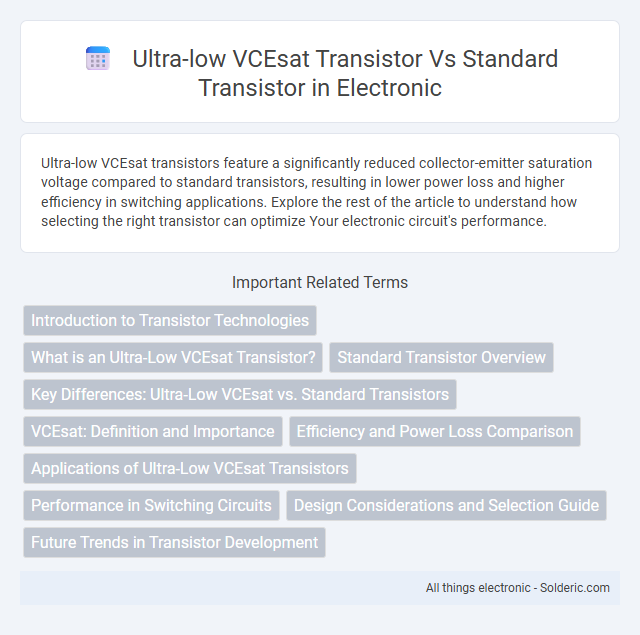Ultra-low VCEsat transistors feature a significantly reduced collector-emitter saturation voltage compared to standard transistors, resulting in lower power loss and higher efficiency in switching applications. Explore the rest of the article to understand how selecting the right transistor can optimize Your electronic circuit's performance.
Comparison Table
| Feature | Ultra-low VCEsat Transistor | Standard Transistor |
|---|---|---|
| Collector-Emitter Saturation Voltage (VCEsat) | Typically <= 0.1 V at rated current | Typically 0.2 - 0.4 V at rated current |
| Power Dissipation | Lower power loss due to reduced VCEsat | Higher power loss due to higher VCEsat |
| Efficiency | Higher efficiency in switching applications | Standard efficiency levels |
| Thermal Performance | Improved thermal management due to lower heat generation | Standard thermal management required |
| Cost | Generally higher due to advanced design | Lower cost, widely available |
| Applications | High-efficiency power supplies, motor drives, battery-powered devices | General purpose switching and amplification |
Introduction to Transistor Technologies
Ultra-low VCEsat transistors feature a significantly reduced collector-emitter saturation voltage compared to standard transistors, enhancing efficiency in switching applications by minimizing power loss and heat generation. These advanced devices leverage optimized semiconductor structures and doping profiles to achieve lower saturation voltages, improving overall performance in high-current, low-voltage circuits. Your choice of transistor technology directly impacts power efficiency and thermal management in electronic systems, making ultra-low VCEsat transistors ideal for modern, high-performance designs.
What is an Ultra-Low VCEsat Transistor?
An Ultra-Low VCEsat transistor is a specialized semiconductor device designed to minimize the collector-emitter saturation voltage (VCEsat), resulting in higher efficiency and reduced power loss compared to standard transistors. This type of transistor is essential in applications requiring high current switching with low heat dissipation, such as power management circuits and battery-operated devices. Your choice of an ultra-low VCEsat transistor can significantly enhance system performance by improving thermal management and energy efficiency.
Standard Transistor Overview
Standard transistors typically exhibit a collector-emitter saturation voltage (VCEsat) ranging from 0.2 to 1.0 volts, which influences power dissipation and switching efficiency. These devices are widely used in general-purpose amplification and switching applications, where moderate performance criteria are acceptable. Their manufacturing process prioritizes cost-effectiveness and robustness over ultra-low saturation voltage, making them suitable for less efficiency-critical circuits.
Key Differences: Ultra-Low VCEsat vs. Standard Transistors
Ultra-low VCEsat transistors exhibit significantly lower collector-emitter saturation voltage, typically under 0.1V, compared to standard transistors which often exceed 0.2V, resulting in higher efficiency and reduced power dissipation. Your choice of ultra-low VCEsat devices enhances performance in high-current switching applications, minimizes heat generation, and extends battery life in portable electronics. Standard transistors, while generally more cost-effective, may not achieve the same low saturation voltage critical for energy-sensitive designs.
VCEsat: Definition and Importance
VCEsat, or collector-emitter saturation voltage, represents the voltage drop between the collector and emitter when a transistor is fully on, directly affecting power efficiency and heat dissipation. Ultra-low VCEsat transistors minimize this voltage drop, reducing energy loss and enhancing overall device performance in high-current switching applications. Your choice of an ultra-low VCEsat transistor can significantly improve circuit efficiency and reliability compared to standard transistors with higher saturation voltages.
Efficiency and Power Loss Comparison
Ultra-low VCEsat transistors exhibit significantly lower saturation voltage, resulting in reduced conduction losses and improved overall efficiency compared to standard transistors. This reduction in voltage drop minimizes power dissipation in switching applications, leading to cooler operation and enhanced energy savings. Consequently, ultra-low VCEsat transistors are preferred in high-efficiency power management circuits and motor drive systems where power loss reduction is critical.
Applications of Ultra-Low VCEsat Transistors
Ultra-low VCEsat transistors are ideal for power-sensitive applications such as battery-operated devices, DC-DC converters, and high-efficiency linear regulators, where minimizing voltage drop is critical to enhance energy efficiency. Their reduced saturation voltage significantly lowers power loss and heat generation compared to standard transistors, making them suitable for automotive electronics, industrial control systems, and precision analog circuits. Incorporating these transistors in your designs ensures improved thermal performance and longer battery life in portable and energy-conscious systems.
Performance in Switching Circuits
Ultra-low VCEsat transistors exhibit significantly reduced collector-emitter saturation voltage, typically below 0.2V, compared to standard transistors, which often have saturation voltages around 0.4V or higher. This lower saturation voltage results in improved efficiency and faster switching speeds in power switching circuits, reducing power losses and heat generation. As a result, ultra-low VCEsat transistors are preferred in applications requiring high-frequency switching and enhanced energy efficiency, such as DC-DC converters and motor drivers.
Design Considerations and Selection Guide
Ultra-low VCEsat transistors feature reduced collector-emitter saturation voltage, enabling higher efficiency and lower power loss in switching applications compared to standard transistors. Design considerations prioritize minimizing voltage drop and thermal dissipation, making ultra-low VCEsat transistors ideal for high-current, low-voltage circuits and battery-powered devices. Selection guides recommend evaluating parameters such as collector current ratings, switching speed, and thermal resistance to ensure compatibility with application-specific demands.
Future Trends in Transistor Development
Ultra-low VCEsat transistors significantly reduce saturation voltage, enhancing efficiency and thermal performance in power electronics compared to standard transistors. Emerging trends prioritize further miniaturization and integration of ultra-low VCEsat devices with advanced materials like GaN and SiC for higher switching speeds and reduced power loss. Future transistor development emphasizes energy-efficient semiconductor architectures, enabling improved performance in electric vehicles, renewable energy systems, and high-frequency applications.
Ultra-low VCEsat transistor vs Standard transistor Infographic

 solderic.com
solderic.com